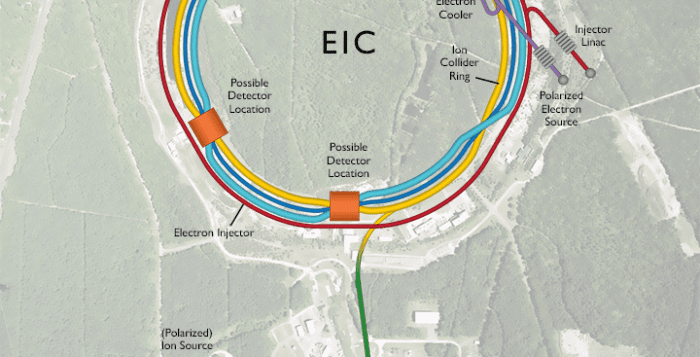By Daniel Dunaief
Through answers to basic questions, scientists develop new technology that changes the world, leading to medical breakthroughs, energy applications and national security devices.
That’s the theory behind the U.S. Department of Energy’s decision last week to award a 10-year project that will cost between $1.6 billion and $2.6 billion to build a new electron-ion collider at Brookhaven National Laboratory in Upton.
For the scientists, the discoveries will flow from answers to questions about the nature of visible matter.
“The big science we’re excited about, the hundred-year-old questions, are things like where does the mass of a proton come from,” said Robert Tribble, the deputy director for science and technology at Brookhaven National Laboratory and a nuclear physicist. The EIC is like a microscope to look at quarks and gluons, he explained.
With support from numerous New York State and Long Island leaders, BNL recently won a competition against Thomas Jefferson National Accelerator in Virginia to build an electron-ion collider. Members of the Jefferson Accelerator, as well as over 1,000 scientists from 30 nations, will partner with BNL staff to conceptualize and build the new collider, which will be the most advanced ever constructed.
In addition to understanding atomic nuclei, we will be able to generate a better view of the universe writ large [with discoveries from the EIC].”
– Robert Tribble
“We do not understand very dense matter that exists in the universe in objects like neutron stars and black holes,” Tribble explained in an email. “In addition to understanding atomic nuclei, we will be able to generate a better view of the universe writ large [with discoveries from the EIC].”
Over the next decade, the construction of the new EIC will employ 4,000 people, said Doon Gibbs, the laboratory director at BNL. That number represents the workforce that will, at one time or another, contribute to the construction of this new facility.
The new EIC will expand on the technology of the Relativistic Heavy Ion Collider, which has been operating since 2000 and will stop running experiments in 2024. Indeed, part of the appeal of BNL as a site for this new facility arose out of the ability to extend the resources by building a new electron storage ring and electron accelerator elements.
Researchers will collide electrons and protons and numerous atomic nuclei to study the strong nuclear force. These collisions will reveal how the subunits of protons and neutrons in the nucleus, namely the quarks and gluons, come together to help generate mass in visible matter.
The staff at BNL is “delighted and excited” that the site for the EIC will be on Long Island, said Gibbs. “Our design has the capability of using many existing technologies and extending them farther than they’ve been before.”
Indeed, even the conception of the EIC has led to some new scientific breakthroughs, some of which the lab and its partners will share with the public in the next few weeks.
While the application of research at the EIC will likely lead to breakthroughs in fields including materials science, researchers at BNL are excited about basic questions about the nature of nuclear matter.
A typical experiment at the EIC will likely follow the same pattern as it has with RHIC, in which hundreds of researchers from around the world collaborate to understand physics properties. In the next few years, researchers will develop a detailed design before they start construction.
“We love challenges at BNL, we like building big machines. We’re good at it. We have a whole class of staff who, in particular, are experts at this kind of activity and they are pretty excited.”
– Doon Gibbs
Gibbs said the facility has a strong handle on the safety features of the new collider, which will build on the protocols and designs developed at the RHIC as well as with the National Synchrotron Light Source II, also at the lab in Upton.
“We love challenges at BNL,” Gibbs said. “We like building big machines. We’re good at it. We have a whole class of staff who, in particular, are experts at this kind of activity and they are pretty excited.”
Area politicians are also excited about discoveries in basic science, translational benefits in areas like medicine and the expected boost to the local economy.
“Establishing the electron-ion collider on Long Island might be focused on particles, but it will add some serious mass — nearly $1 billion worth — to the local economy,” U.S. Sen. Chuck Schumer (D) said in a statement. BNL has the “talent, the technology and the track record to make the most of this national project.”
Schumer believes this project will guarantee that BNL continues to be a “world class research facility for the next generation.”
U.S. Rep. Lee Zeldin (R-Shirley) praised the leadership at BNL.
“I congratulate BNL Director Doon Gibbs for leading this exceptional organization and all of its scientists who have worked incredibly hard every step of the way to make this possible, and can’t wait to see what they do next,” Zeldin said in a statement.





